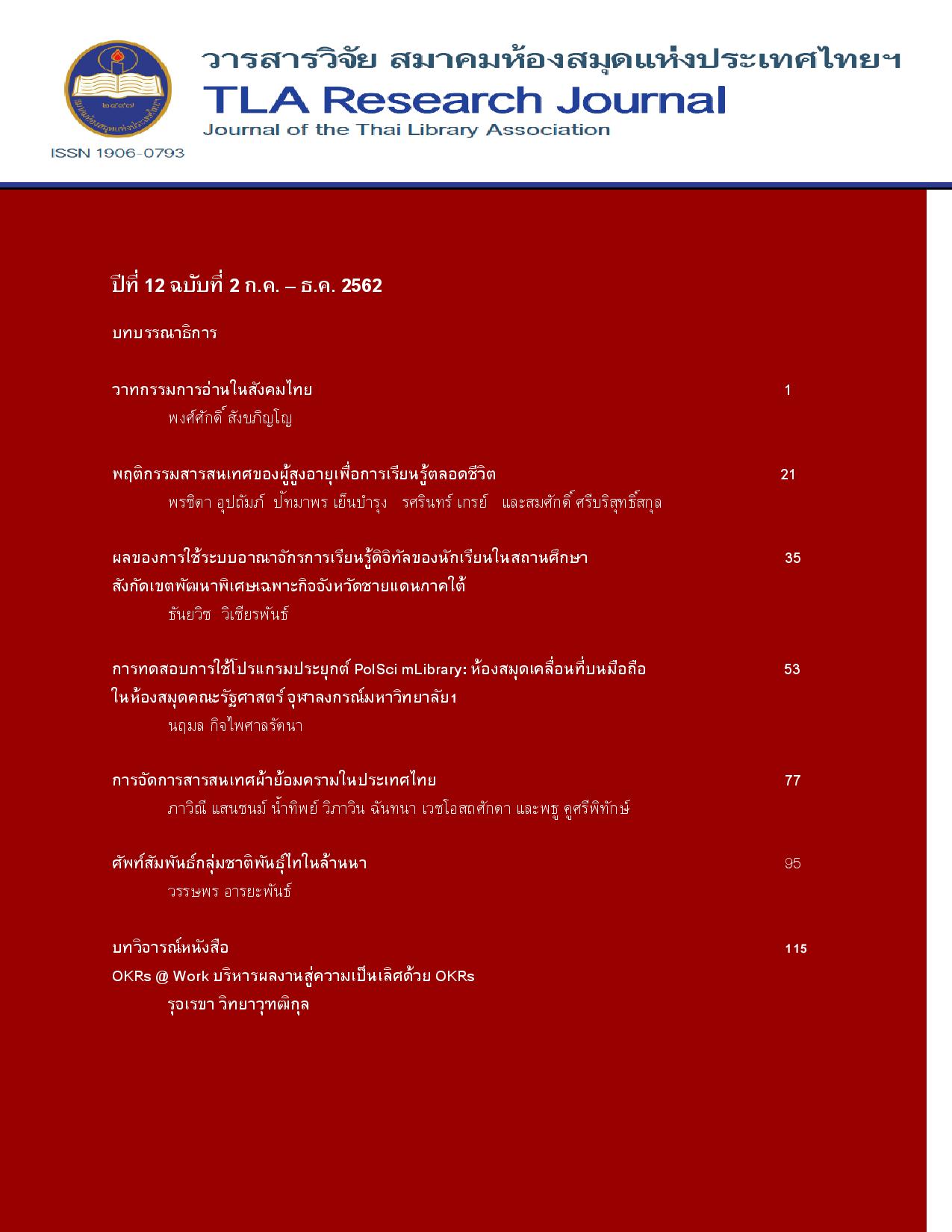การทดสอบการใช้โปรแกรมประยุกต์ PolSci mLibrary: ห้องสมุดเคลื่อนที่บนมือถือ ในห้องสมุดคณะรัฐศาสตร์ จุฬาลงกรณ์มหาวิทยาลัย
Main Article Content
บทคัดย่อ
งานวิจัยนี้เป็นการประเมินคุณลักษณะของโปรแกรมที่พัฒนาเพื่อการใช้บริการในห้องสมุดคณะรัฐศาสตร์ผ่านโทรศัพท์มือถือทั้งบน iOS และ Android มีวัตถุประสงค์เพื่อประเมินคุณลักษณะด้านการเข้าถึง ความชัดเจน ความง่าย ประสิทธิภาพ ข้อผิดพลาด ประสิทธิผล ประโยชน์ และความพึงพอใจ ประเมินความพึงพอใจในการใช้บริการของห้องสมุด และสอบถามความคิดเห็นในการใช้โปรแกรมเพื่อพัฒนาแนวทางการบริการของห้องสมุด ขั้นตอนการศึกษาประกอบด้วย การทดสอบการใช้งานจริง (Accomplishing tasks) และสอบถามความคิดเห็นที่มีต่อคุณลักษณะในภาพรวม (Post-test) จากกลุ่มเป้าหมาย 12 คน และการสอบถามความพึงพอใจในภาพรวมจากกลุ่มตัวอย่าง 164 คน ผลจากการวิจัยพบว่า PolSci mLibrary เป็นโปรแกรมที่เป็นประโยชน์ สามารถเข้าถึงข้อมูลและบริการได้สะดวก ชื่อและข้อความที่ปรากฏบนจอโทรศัพท์มือถือมีความชัดเจน จดจำง่าย ข้อผิดพลาดของระบบมีน้อยที่สุด โดยรวมผู้ใช้พึงพอใจโปรแกรมระดับมาก และจากการศึกษาความพึงพอใจในการใช้บริการในภาพรวมที่มีต่อการใช้ พบว่าผู้ใช้พึงพอใจโปรแกรมนี้ในระดับมากเช่นเดียวกัน และเห็นว่าเป็นโปรแกรมที่เป็นประโยชน์และสามารถตอบสนองความต้องการของผู้ใช้ได้
Article Details
บทความทุกเรื่องที่ลงตีพิมพ์จะได้รับการตรวจอ่านโดยผู้ทรงคุณวุฒิ ความคิดเห็นและบทความที่ปรากฏในวารสารนี้ เป็นของผู้เขียนซึ่งมิใช่เป็นความคิดเห็นของคณะผู้จัดทำ และมิใช่ความรับผิดชอบของสมาคมห้องสมุดแห่งประเทศไทยฯ การนำบทความในวารสารนี้ไปตีพิมพ์ซ้ำต้องได้รับอนุญาตจากคณะผู้จัดทำ
All articles submitted for publication will be reviewed by the academic reviewers. The editorial board and TLA claim no responsibility for the content or opinions expressed by the authors of individual articles or columns in this journal. Reprinting of any articles in this journal must be permitted by the editorial board.
References
Weekly News, 10(48), 1. Retrieved November 8, 2019. http://library.cmu.ac.th /prcorner
/sites/default/ files/ images2559/10-49_23-29%E0%B8%9E%E0%B8%A258.pdf
Battleson, B., Booth, A., & Weintrop, J. (2001). Usability testing of an academic library website: A
case study. The Journal of Academic Librarianship, 27(3), 188-198.
Bridges, L., Rempel, H., & Griggs, K. (2010). Making the case for a fully mobile library web site: from
floor maps to the catalog. Reference Services Review, 38(2), 309-320.
Chaimin, K. (2014). Android and IOS applications for CMU e-Theses and CMU e-Research. PULINET
Journal, 1(1), 38-44. [In Thai]
Chang, C. (2013). Library mobile applications in university libraries. Library Hi Tech, 31(3), 478-492.
Denton, W., & Coysh, S.J. (2011). Usability testing of VuFind at an academic library. Library Hi
Tech, 29(2), 301-319.
Iqbal, M, & Warraich, N.F. (2012). Usability evaluation of an academic library website: A case of the
University of the Punjab. Pakistan Journal of Information Management and Libraries, 13(1), 1-11.
Islam, M.A., & Tsuji, K. (2011). Evaluation of usage of university websites in Bangladesh. Journal of Library & Information Technology, 31(6), 469-479.
Kaewnium, K. et al. (2014). The book hunter: mobile application for identifying the location of library
information resources. PULINET Journal, 1(1), 55-60.
Karim, N. S. A., Darus, S. H., & Hussin, R. (2006). Mobile phone applications in academic library
services: a students’ feedback survey. Campus-Wide Information Systems, 23(1), 35-51.
KKU Parasite hunt. (2016). Retrieved November 8, 2019. https:/cascap.kku.ac.th/kku-cascap-app/
Lih-Juan, C., & Hung, W. (2016). Usability and evaluation of a library mobile web site. The Electronic
Library, 34(4), 636-650.
Meet Libby: the one-tap reading app from your library. (2017, July 17). Retrieved November 8, 2019.
http://www.quickpconline.com/pc/mobile-device/apps/tk-park-libby-by-overdrive/
Miller, R. F., Vogh, B. S., & Jennings, E.J. (2013). Library in an app: testing the usability of Boopsie
as a mobile library application.” Journal of Web Librarianship, 7(2), 142-153.
Muangpool, T., & Intharasombat, O. (2016). Performance evaluation of instructional media in
topic English vocabulary on android operating system for primary students grade 1. In
The 3rd ed. National Conference on 2nd ed. Decade: Research Integration, Knowledge Management
and Sustainability, June 17, 2016. Nakhonratchasima College, Nakhon Ratchasima.
Negi, D.S. (2014). Using mobile technologies in libraries and information centers. Library Hi Tech,
31(5), 14-16.
Nielsen, J. (2012). Usability 101: introduction to usability. Retrieved March 27, 2018.
https://www.nngroup.com/articles/usability-101-introduction-to-usability/
Nowlan, G. (2013). Going mobile: creating a mobile presence for your library. New Library World,
114(3-4), 142-150.
Pasur, I. (2014). Attitude of the Rudjer Boskovic Institute’s Scientists to the small screen mobile
devices library services: a user survey. Library Hi Tech, 32(4), 628-644.
Paterson, L., & and Low, B. (2011). Student attitudes towards mobile library services for smartphones.
Library Hi Tech, 29(3), 412-423.
Pendell, K. D., & Bowman, M.S. (2012). Usability study of a library’s mobile website: an example from
Portland State University.” Information Technology and Libraries, 31(2), 45-62.
Pu, Y., Chiu, P., Chen, T., & Huang, Y. (2015). The design and implementation of a mobile library
APP system. Library Hi Tech, 33(1), 15-31.
Sairos, A. (2016). MSU help desk application. PULINET Journal, 3(3), 45-53. [In Thai]
Shieh, J.C., & Liu, C.F. (2010). The usability evaluation study of the university library websites.
Journal of Educational Media and Library Science, 47(2), 163-198.
Sukpinyo, P., Purimpaiboon, P., & Chankaew, W. (2018). UP LIB an alternative for the new
generation. PULINET Journal, 5(3), 15-24. [In Thai]
Sukwichai, W., & Thempornsin, J. (2018?). No time to go to library use MSU LibraryGo.App.
Retrieved November 8, 2019. http://pulinet2019.buu.ac.th/Documentation/Proceeding/
Oral/IT/11.pdf
Surathamjanya, R. (2015). The result of using application for teaching English vocabulary on tablet in
English subject for Prathomsuksa 2 students in Ratchaburi Educational Service Area 2.
Master’s Thesis, Graduate School, Silpakorn University, Nakhon Pathom.
Tanjaro, K., & Chinbordee, P. (2014). Application “RSU Library eBook. RSU Library Journal, 20(2),
111-125.
Travis, D. (2011). 4 forgotten principles of usability testing. Retrieved January 8, 2016.
http://www.userfocus.co.ukarticles /4-forgotten-principles-of-usability-testing.html.
Tsiaousis, A.S., & Giaglis, G.M. (2014). Mobile websites: usability evaluation and design.
International Journal of Mobile Communications, 12(1), 29-55.
Vanichbuncha, K. (2003). Using SPSS for Windows for data analyzing. 6th ed. Bangkok:
Department of Statistics, Chulalongkorn Business School, Chulalongkorn University.
Wallace, S., Reid, A, Clinciu, D., & Kang, J. (2013). Culture and the importance of usability sttributes.
Information Technology & People, 26(1), 77-93.
Wei, Q.Y., Hou, G.N., & Hou, R. (2013). A study on practical and developing status of Chinese mobile
libraries: based on the investigation of 985 academic and provincial public libraries. Library,
(1), 114-117.
Wei, Q., Chang, Z., & Cheng, Q. (2015). Usability study of the mobile library app: an example from
Chongqing University. Library Hi Tech, 33(3), 340-355.
Yeh, S.T., & Fontenelle, C. (2012). Usability study of a mobile website: The Health Sciences Library,
University of Colorado Anschutz Medical Campus, experience. Journal of the Medical Library
Association, 100(1), 64-68.
Yong, K., Hye, K.K., Ee-gyeong, K., & Geon, K. (2014). Archival information services based on social
networking services in a mobile environment: a case study of South Korea. Library Hi Tech,
32(1), 28-49.
Zhang, D, & Adipat, B. (2005). Challenges, methodologies, and issues in the usability testing of
mobile applications. International Journal of Human Computer Interaction, 18(3), 293-308.

